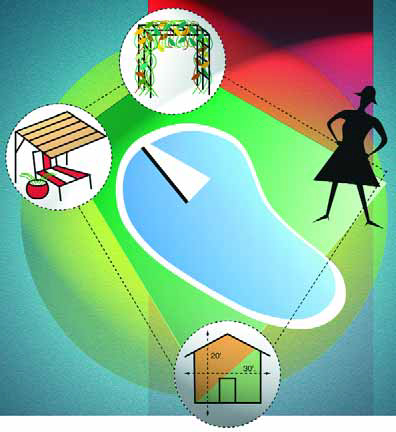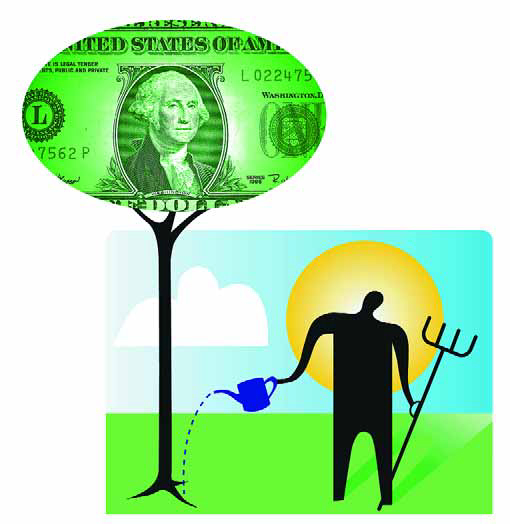Natural Companions
More and more of my clients are interested in including edible plants in their gardens. They're into cooking, great food, fine wine and entertaining, and they appreciate the special flavors that come when they grow and harvest their own edibles. It's incredibly satisfying to walk out into one's own garden and pick fruits or vegetables or herbs. Not only do these edibles taste better than store-bought produce, but any gardener can be reasonably sure that the foods they grow are free of pesticides and other undesirable contaminants. No matter what
Summer is arriving, and those 90-degree-plus days are coming with it. Your clients are thrilled to have their watershapes to cool off in, but they can't spend all their time in the water! I've discussed shade structures and shade trees before, and it's an important feature to discuss with any clients whose yard you are designing. But there's more to shade than what you do overhead, and you need to discuss what you'll be planting in those shaded areas. There are two problems here. For the most part, people don't know what to plant in the shade - nor do they
Contrary to the impression that might be given by the headline, this isn't an article about building arbors that are safe. Rather, it's about how you can protect your clients and their guests from the sun by building beautiful structures in their yards. (Safety is part of the discussion, too, but not its focus.) I bring this up because many clients put piles of money into building spectacular pools but fail to give much thought to their surroundings. That's a shame, because those surroundings almost certainly will be seen much more than the pools will be used in the course of the average year. Several things need to be
When I meet with clients for the first time, we talk a lot about what style, design, color and other elements appeal to them. We also talk about whether they want a low-maintenance garden, or whether they want to put a lot of work into their own high-maintenance yard. Consistently, however, I find that people do not even remotely understand what I mean by "maintenance." I hear things like, "I don't need a sprinkler clock," or, more truthfully, "I don't want to spend the money on a sprinkler clock" - and I immediately
I feel like I'm working backward: First, I told you about a gargantuan water lily and its very specific requirements, then I offered a more general look at water lilies that will thrive in almost any pond. Now I'm going to give you some ideas and tips for designing with all types of water plants. It might have been more logical to approach things the other way around, but the important thing is that we're ready to complete the package and talk about ways of incorporating lilies and water plants of other sorts into beautiful, overall planting designs. As always, I will avoid getting too specific with recommendations. Instead, I'll stick to basic
So you read my last article and were so excited about Amazonian Water Lilies that you'd decided to talk some clients into going for it. But alas, after measuring their yard, you recognize that you won't have enough room to accommodate the gargantuan watershape you'll need to host such an immense plant. But your clients are still hot to trot with something unusual, even after you've accepted the fact that
This past summer, I had the pleasure of traveling to Europe - specifically Northern Italy and Southern France. Along the way, I was lucky enough to see the lavender fields of Provence in peak bloom and many unusual and beautiful gardens. My travels were particularly rewarding in the region around Lake Maggiore in Northern Italy, well known for having some of Europe's most beautiful gardens. We started off by visiting the islands on the lake and their villas, complete with their classic-style gardens. The climate of the area allows for growing many of the plants I'm familiar with in Southern California, but the
As fall looms before us, it's timely to consider a question that should be a factor in every design we prepare: To drop or not to drop? This question is a good one to ask before you start planning and has to do with how much natural debris your clients will be willing to fish out of their watershapes once you're gone. In other words, while it's always important to decide what style of plants to put around your watershapes, it's also important to think about types - that is, evergreen vs. deciduous. I'm sure most (if not all) of you are aware of the general distinction, but here's a short
Is one person's trash really another person's treasure? That's a concept we tested on a recent Surprise Gardener episode, where we ran into a strange backyard "centerpiece" and, as the designer with final say, I had to decide whether to cover the thing up or make it stand out. The challenging objet d'art was an old truck chassis, abandoned and sunk into the yard many years before. Because of its location, it was something of a focal point. The homeowner had tried sticking an old whiskey barrel in the middle of the truck as a planter in hopes of






















